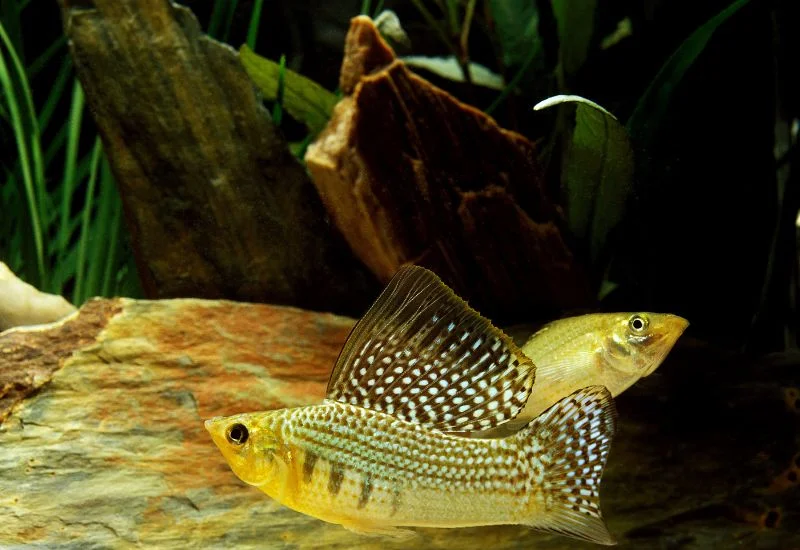The Molly fish is famous due to its different choices of colors. The fish is happy, energetic, and easy to care for. The fish is calm and can cohabitate with many other species.
Mollies can adjust to different environments but lack of knowledge regarding their preferred habitat. Diet, tank mates, and water parameters can cause several health problems.
Many new aquarists need assistance in addressing these problems. In this article, you will learn how to care for your molly fish.
Overview of Molly Fish
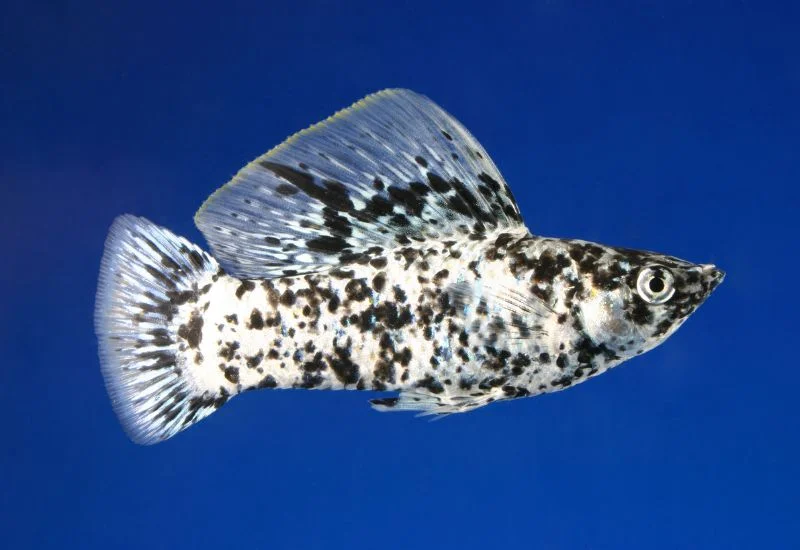
Molly fish are found in brackish, freshwater, and saltwater habitats, ranging from the southern United States to Colombia. The scientific name of the molly fish is Poecilia; they were named after the family of Poeciliidae. The size of the molly fish can reach up to 5 inches. Molly fish not only eat uneaten food but keep your tank clean by eating algae. Molly fish is a livebearer fish that gives birth to young and independent babies.
How to Set up a Tank for Mollies?
Here are the things you need to do before setting up the tank:
Tank Size
Molly fish need a tank of 20 gallons. For large species, 50 to 55 gallons are recommended. Before adding them to the tank, make sure to cycle it. The cycle will place the beneficial bacteria into the tank. There should not be any amount of ammonia and nitrite, 30 ppm quantity of nitrate is acceptable.
Water Parameters
Molly fish thrive in a range of water types and require temperatures between 75° F and 80° F. The water pH should be from 7.5 to 8.5. There should not be any harmful chemicals in the water. The GH should be from 200 ppm to 416 ppm. KH of the water should be 178 ppm to 450 ppm. Adding crushed coral into the substrate can increase the hardness of the water. The charcoal will filter calcium and carbonate from the water.
Salt in Their Tank
It is debatable whether molly fish need salt in their water. It is a universal debate, and both aspects of it are right. Molly fish do not need salt in the water; they can just adapt to different water parameters. They can adapt to salt water or brackish water if they have to. Some mollies thrive in saltwater and need salt in the tank because their bodies are accustomed to it. You can ask about their water condition to the store owner before buying.
Heater
Molly fish are tropical fish that need the water temperature from 75° F to 80° F. The heater is essential for providing them with preferred water parameters.
Filtration
Molly fish are beautiful, but they are a little messy. You need to install a good filter that can handle huge bioloads. Add as much filtration as you can. You can add internal filtration, like a filter sponge.
Substrate
You can use aragonite as the substrate. It naturally forms in mollusk shells. It drains the carbon and calcium from the water, which is beneficial for the health of fish. If you have already set the gravel as a substrate, you can add crushed charcoal to the tank to increase the water hardness. It will work the same as the aragonite.
Plants and Decor
Molly fish are surface dwellers and like to swim. The fish is energetic and needs space to play. But they also like to hide out. You can add dense plants, rocks, and driftwood. Here are the plants you can add to your molly fish aquarium:
- Java moss
- Java fern
- Christmas moss
- Anubias
- Rotalas
- Cryptocorynes
Tank Mates For Molly Fish
Molly fish are peaceful but schooling fish. Living in a group of 6 or more keeps them happy. It is best to keep one male for three females. Male molly fish harass the female for mating. Having three females can reduce the attention of males. The fish can become competitive during feeding. Add the fish that is fast or live in another part of the tank. Here is the recommended fish that can cohabitate with molly fish:
- Tetras
- Swordtail
- Bristol pleco
- Clownfish
- Corydoras catfish
- Platies
- Danios
What Molly Fish Eat
Molly fish eat everything you put into the tank. They are not picky eaters. The fish are surface feeders that provide them with food that does not sink quickly. You can give them pellets, flakes, freeze, or dried food. Molly fish also enjoy eating algae from the bottom of the tank. Make sure to provide food with all the necessary nutrients. You can try algae wafers and sheets. Do not overfeed your fish, give them food that they can consume within 2 to 3 minutes. Overfeeding will not only impact the water conditions of the tank but will cause several health problems for the fish.
Breeding of Mollies
Breeding mollies is easy if you follow all the needed steps:
Create a Breeding Environment
Male molly fish are bigger and have larger fins and vibrant colors. That means three females for one male is best. Put the breeding pair into a separate tank. For breeding, you can see the male under the female. This is how they copulate. After the breeding, the babies can come within 3 to 5 weeks.
Remove the Male From the Tank
After breeding, remove the male from the nursing tank. The male can cause stress to the female to more copulate. This can cause stress on the pregnancy. You can tell if the female is pregnant by their distended belly. If you do not have a separate tank, you can make a partition using a net. This will protect the mother and fry from any harm.
Remove Female Fish From the Tank
After the birth, the female may eat the young fry. Remove the female from the tank and add her into the established tank. You may need to re-segregate the female as they can retain multiple fertilized eggs for half a year.
Care of Fry
Feed crushed fish food that you fed your adult fish. Flake food can be used as a primary base. Worms are a great food source for the mollies. You can feed them live blood worms, black worms, and grindal worms. Brine shrimp and frozen food are good, too. The fish also eat algae, which is a primary food source in the wild.
Wait For the Fry to be Mature
In two months, molly reaches their sexual maturity. You can tell the difference between males and females. When they are double their size, it’s time to introduce them to the established tank. Another indicator is when they are large enough not to fit in the mouths of other fish; then, you can introduce them to the tank.
Separate the Male and Female
You need to separate the males and females to prevent extra breeding. You can separate them when they are eight weeks old. Put them into a separate tank.
A Common Disease of Molly Fish
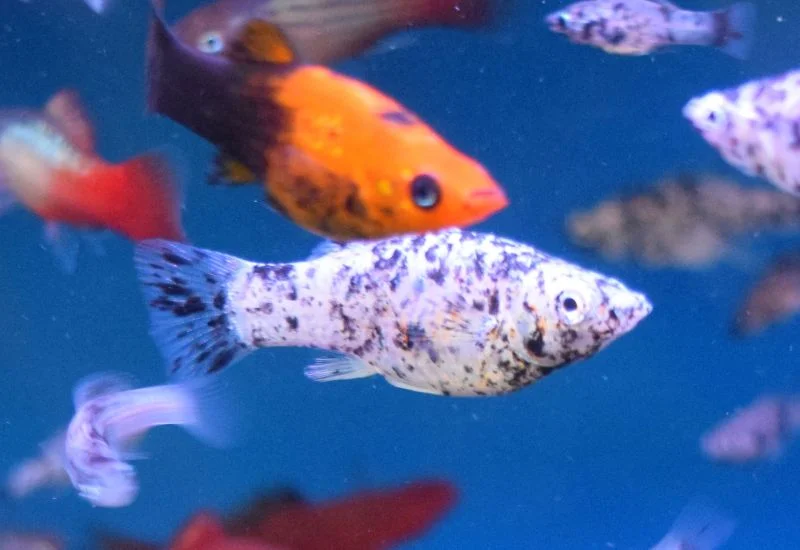
Here is a list of common diseases in molly fish:
ICH
This is a disease caused by water parasites. The poor water quality can lead to sickness. The entry of new fish without quarantining them first can be a problem. The new fish can be already sick. The symptoms can be small white spots on the skin of fish that look like a grain, difficulty breathing and rubbing against the objects in the aquarium.
Treatment
You can increase the water temperature from 75° F to 80° F. This will increase the life cycle of parasites. Remove the decorations from the tank and change 20% to 25% of the tank water. Add aquarium salt to the water. One teaspoon per gallon. Repeat this process after every 12 hours. Three times in total. After that, change the 50% to 70% of aquarium water.
Buoyancy Issues
This disease is also known as Swim Bladder Disease. The reason can be overfeeding or poor diet. The symptoms can be constipation, upside down, and fish appearing to be enlarged.
Treatment
Check the water parameters of the tank. See if there are any harmful chemicals in the water. Maintain the water quality. Do not feed your fish for three days. If there is still no improvement, consult the vet.
Fin/Tail Rot
This disease can be caused by poor quality of water, aggressive and crowded tanks, and sudden changes in the water parameters of the tank. The symptoms can be the fin and tail of the fish appear to be torn or raggy.
Treatment
Put the infected fish into a separate tank. Remove all decorations and gravel. Wash them with hot water. Do not use any soap or detergent. Change the water in the tank. Check the water pH and quality to provide the preferred environment. If there is still no change in the behavior of the fish, consult the vet.
Velvet
The reason for this disease can be stress, poor water quality, or entry of new infected fish. The symptoms can be difficulty breathing, the appearance of fungi on the body that give a velvety appearance, and rubbing against the object in the tank.
Treatment
Put the infected fish into the quarantine tank as the disease is contagious. Do a 100% water change. Clean the tan. Wash all decor and gravel with hot water. Do not use any detergent or soap. Consult the vet for anti-bacterial medication.
Preventive Measures
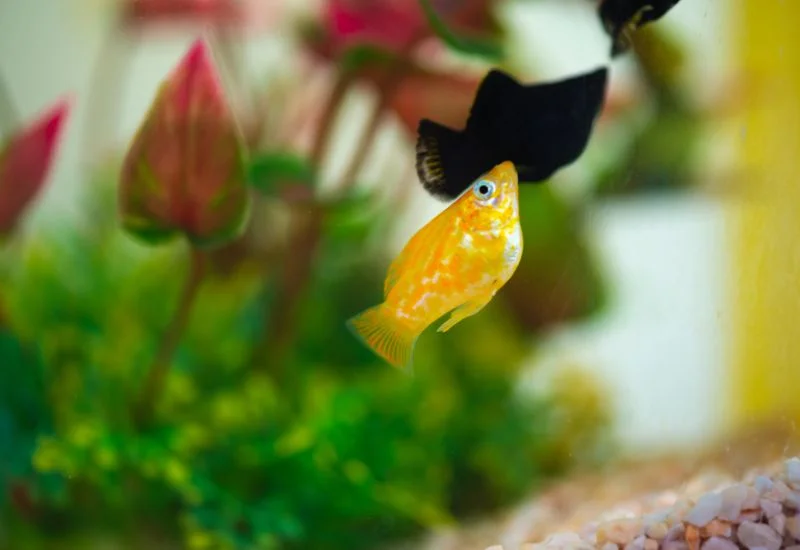
Here are some tips to prevent any disease:
Provide a Balanced Diet
Provide a well-balanced and nutrient-rich diet to keep your fish healthy and for a strong immune system.
Quarantine new Fish
Do not add the new fish to the established tank. Keep the fish in the quarantine tank for two weeks to see for signs of illness.
Do not Overcrowd the Tank
Do not overcrowd the tank; it can cause stress and aggression to the fish. Add fish according to their space requirements.
Maintain the Water Quality
Maintain the water quality of the tank, change the water at regular intervals, and ensure the filter is working properly. Test the water for any harmful chemicals like ammonia and nitrite. The bad water conditions weaken the immune system of fish and make them more open to disease.
Health Consideration of Molly Fish
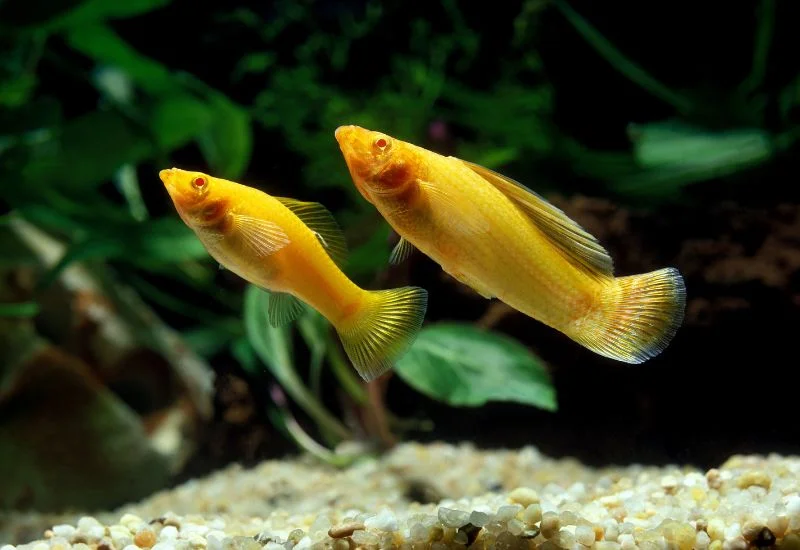
Here are the points you should keep in consideration to provide a good lifespan for the fish:
- Maintain the water quality by testing the water. There should not be any harmful chemicals like ammonia in the water.
- The temperature and pH of water should be maintained as per the needs of the fish
- Provide a quality and balanced diet rich in nutrients
- You can feed them pellets, flakes, frozen food, live bloodworms, and blackworms
- The tank size should be the fish’s preference. There should be space to swim and hide that will affect the overall being of the fish
- Add peaceful tank mates who can perfectly cohabitate with your fish
- Monitor your fish for any sign of stress or illness
Conclusion
Molly fish are a great choice of aquatic hobby because of their different colors. The difference between males and females can be attributed to their physical appearance. The fish is not a picky eater. They have almost everything that fits into their mouth.
The fish’s personality is peaceful, and it can live with many other species. Do not keep one female with one male. It will put females under stress. One male for three females is recommended. The fish is easy to care for but needs little attention and clear water. Make sure to provide stable water conditions by managing the temperature and pH of the tank. Do not overfeed your fish. It can cause several health problems.
